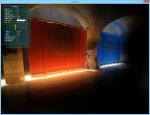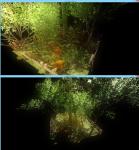Cuboid Engine is a graphical rendering framework developed by me over time as a hobby, I simply have one rule:
Keep, Everything, Realtime!
Which essentially means I don’t bake any lighting information, which is a heavy hit on performance and increases the challange! 🙂
The images below do not represent all features but some in the current state of the engine, the first 4 images represent some features of the current state of the engine:
The rendering system follows a deferred path, looking past the regular features of /graphics engines, this engine shines in the following:
- Cascaded Custom Light Propagation Volumes GI System ( With a Low and High Frequency buffer per cascade )
- BRDF Shading
- Luminance Adaptation
- High Quality Tone mapping (+Bloom Effect)
- Per LightSource Volumetric Lighting ( RayMarched )
- Currently Discontinued Screen Space Reflections seen on the law few images.
- Including a few minour effects that overall contribute to the image
With all features enabled the engine runs at a steady ~100 fps ( ~10 ms ) on my GTX 970 at a resolution of 1920×1080.
The rendering system is based on DirectX 11 and written in C++. It also has a great layer of flexibility, allowing the user to create his own materials without breaking the pipeline (Such as voxelization on any material given), such as:
Shader
{
// Include the CG Data Layouts
#include "cg_layout.hlsl"
// Define the return types of the shader
// This stage is really important to allow the parser
// to create the geometry shader for voxelization
// and also if the user has created his own geometry shader, so that it can figure
// out a way to voxelize the mesh properly, in this way the user
// can use ALL stages of the pipeline (VS, HS, DS, GS, PS) without
// voxelization not being possible.
// The only problem is well, he has to write the stuff below: ( Even more if he used more stages )
#set CG_RVSHADER Vertex // Set the return type of vertex shader
#set CG_RPSHADER
#set vert CG_VSHADER // [Opt] Set the name of the vertex shader instead of writing CG_VSHADER
#set pix CG_PSHADER // [Opt] Set the name of the pixel shader instead of writing CG_PSHADER
// This is his stuff
// He can do whatever he wants!
Texture2D T_Diffuse : register(t0);
Texture2D T_Normal : register(t1);
// Basic VS -> PS Structure
// This structure inherits the "base" vertex, stuff that the engine can crunch on
struct Vertex : CG_VERTEXBASE
{
// Empty
};
// Now include some routines that's needed on the end of all stages
#include "cg_material.hlsl"
// Vertex shader
Vertex vert(CG_ILAYOUT IN)
{
// Zero set vertex
Vertex o = (Vertex)0;
// Just let the engine process it
// Although we could do it outselves, but there's no need
CG_VSPROCESS(o, IN);
// Return "encoded" version
CG_VSRETURN(o);
}
// Pixel Shader
// In this case the return type is FORCED! As it's a deferred setup
CG_GBUFFER pix(Vertex v, bool IsFrontFace : SV_IsFrontFace)
{
// Basic structure containing info about the surface
Surface surf;
// Sample color
float4 diff = CG_TEX(T_Diffuse, v.CG_TEXCOORD);
// Simple alpha test for vegetation
clip(diff.a - 0.1001);
// Fill out the surface information
surf.diffuse = diff;
surf.normal = CG_NORMALMAP( // Do some simple normal mapping
T_Normal,
v.CG_TEXCOORD,
v.CG_NORMAL * ((IsFrontFace) ? 1 : -1), // Flip the normal if backside for leaves
v.CG_TANGENT, v.CG_BINORMAL
);
surf.subsurface = 1; // I've got a simple version of some ssss, but it's not very good yet.
surf.thickness = 0.1; // For the sssss ( Want more s's? )
surf.specular = 0.35;
surf.anisotropic = 0.2;
surf.clearcoat = 0;
surf.metallic = 0;
surf.roughness = 0.65f;
surf.emission = 0;
// Return "encoded" version
// Aka compress the data into the gbuffer!
CG_PSRETURN(v, surf);
}
};











